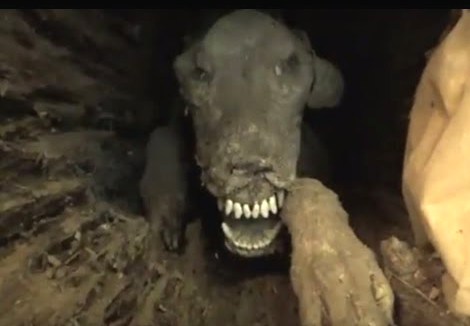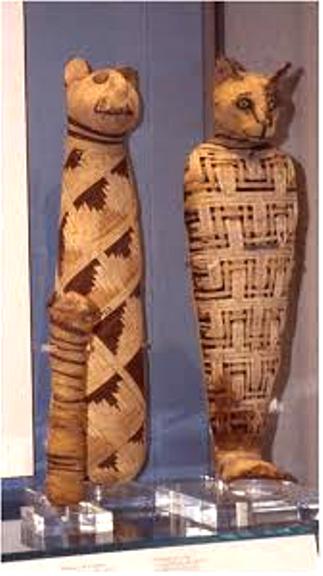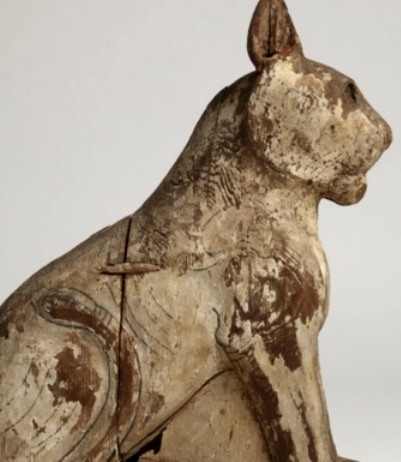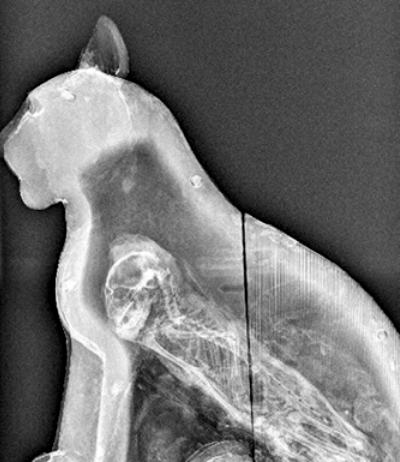

On this month's Morbidly Fascinating Page:
Mummified dog was stuck in a tree (after chasing a raccoon or other small animal) for over two decades
IN THE ARCHIVES:
Two-Faced
Hyperdontia
Preserved
Circus Curiosities
Accidental Victim Photos
Head Dents
Ghosts of Alcatraz

Dog found mummified inside tree trunk after getting stuck chasing small animal
When loggers for The Georgia Kraft Corp. cut off the top of a chestnut oak tree to load it into a transport truck, they saw a brown and white hunting dog peering out at them from the hollow space in the log. But the loggers were about two decades too late to save the canine from his woody fate. All that was left was a dried, mummified hound, petrified in an eternal struggle to escape.
The year was approximately 1960 when the dog ran into a hole at the bottom of a tree and shimmied 28 feet up. “He’s a hunting dog, so we assumed that he was chasing something in the tree,” Bertha Sue Dixon, who runs a museum called Southern Forest World, told Newsweek. (Southern Forest World is where the dog now resides.)
But as the tree narrowed, the dog became stuck. He never caught his prey and no one pulled him out. Unable to escape, he remained in the accidental trap and perished.
Twenty years later, loggers found the immobile canine. Instead of pulping the log, they donated it whole to Southern Forest World. “Stuckie,” as the dog would later be named, has been the star attraction ever since. Even today, viewers can see the hound through glass into the tree where he is still reaching out for freedom that will never come.
But how did this dog’s body stay preserved for so long when there was no Egyptian mummifying technique to preserve him? The properties of his wooden tomb did the work.
Kristina Killgrove, a biological anthropologist at the University of West Florida, studies decay in humans and explained how the tree itself dry-preserved the dog.
Normally when a person or an animal dies, the microbes in the body are left unchecked by biological processes that keep them under control in living creatures. Without the usual guardians in place, they begin to eat the body, and then the microorganisms in the gut start the process of putrefaction. “They grow, they reproduce, and they start taking over the body,” Killgrove told Newsweek. “That’s the disgusting part.” The body bloats and decays, and bacteria, fungi, insects and other animals come to eat the remains.
But this isn’t what happened with Stuckie in that chestnut oak that would become his coffin. Chestnut oaks contain tannin, which is used to tan animal pelts and prevent decay. Tannin is a natural “desiccant,” or material that absorbs moisture and dries out its surroundings.
The low-moisture environment stopped the microbial activity, Killgrove explained. And no microbial activity means no decay.
See more HERE
See the Southern Forest World HERE


What about animal mummies in ancient Egypt?

Ancient Egyptians created animal mummies for various reasons. Some were household pets buried alongside their deceased owners, or other animals that held special importance to the humans around them. Some mummified animals were intended as food offerings to humans in the afterlife. Many others were created to serve as sacred offerings to the gods, who in ancient Egypt often took animal form, including cats, cows, falcons, frog, baboons and vultures, among many others.
Animals mummified for this last purpose were available for purchase or barter at sacred sites. The people who bought them would often give them to a priest, who would then bury collections of the animals as a gift for the gods. This practice, similar to the act of lighting a votive candle at a church, was so widespread in ancient Egypt that animal mummification exploded into big business. Archaeologists have found 30 catacombs in Egypt, each one dedicated to a single animal and each packed floor to ceiling with mummies, for a total numbering in the millions.
In the largest study of its kind, researchers at the Manchester Museum and the University of Manchester have used X-rays and CT scans to examine more than 800 ancient Egyptian animal mummies, many of which are now housed in British museums. The animals examined ranged from birds to cats to crocodiles, with many others in between. While a third of the mummies contained the well-preserved remains of complete animals, researchers found only partial remains in another third of the mummies.
See more HERE

